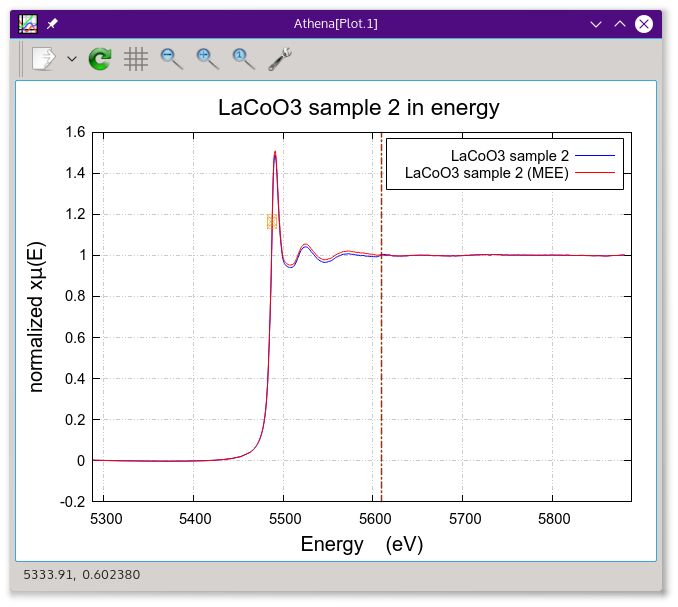9.11. Multi-electron excitation removal¶
 XAS is normally thought of in terms of a single
electron phenomenon. A photon goes in and a photoelectron goes out. In
fact multi-body phenomena are possible and, on occasion, must be
considered in the interpretation of XAS data. One such is the
so-called “shake-off” effect in which the photoelectron has
sufficient kinetic energy to excite a high-lying electron. For
example, at around 415 eV above the uranium LIII edge, the
photoelectron can excite an N6 or N7 transition.
XAS is normally thought of in terms of a single
electron phenomenon. A photon goes in and a photoelectron goes out. In
fact multi-body phenomena are possible and, on occasion, must be
considered in the interpretation of XAS data. One such is the
so-called “shake-off” effect in which the photoelectron has
sufficient kinetic energy to excite a high-lying electron. For
example, at around 415 eV above the uranium LIII edge, the
photoelectron can excite an N6 or N7 transition.
The cross-section of this secondary edge can be quite small. In the example of the LIIIN6,7 transition, the secondary cross section is about 3 orders of magnitude smaller than the primary LIII edge. If, in this example, you have very good data with measurable EXAFS beyond about 10.5 Å-1, the multi-electron excitation will not be small compared to the LIII EXAFS. Other multi-electron excitations have even larger cross-sections compared to their primary excitations. For an excellent discussion of multi-electron excitations see Iztok Arcon's Multielectron photo excitations page.
Another phenomenon which is somewhat similar in its effect on your data is the presence of a small impurity of the Z+1 element, leading to a small edge step well above the measured edge. In some cases this small edge step might be hard to see in your μ(E) data, but are clearly visible as a step in the χ(k) which Fourier transforms into a low-R contribution in the χ(R) spectrum.
ATHENA offers two relatively simple algorithms to attempt to remove the effect of a step due to multi-electron excitations or small impurities from your data. One models the multi-electron excitation as a reflection of the data translated to the position in energy of the excitation. The other places an arctangent function at the specified energy.
Caution
The algorithm described here requires considerable user input and sufficient knowledge to reasonably process the data. In no case will the result be perfect. Use this tool carefully!
That said, let's carry on.
Unfortunately, ATHENA has no practical way of guessing sensible starting values for the three parameters. So it is entirely up to the user to set these appropriately.
Shown below are data on LaCoO3 which display a [3p4d]5d excitation at about 120 volts above the edge.
For more information about multi-electron excitations, see
- A. Kodre, I. Arcon, M. Hribar, M. Stuhec, F. Villain, and P. Parent. Double photoexcitation [2(s,p)4(p,d)] in the Xe-isoelectronic series Cs+, Ba2+, La3+. J. Phys. IV, 4(C9):C9–397 – C9–400, 1994. doi:10.1051/jp4:1994966.
Using the parameter shown in the screen shot above, the removal is performed and shown as the red line in the figures. The shift was first guessed as the separation between the white line in the XANES data and the prominant feature at 5.7 Å-1. That came out to be 121.04 eV. After a bit of examination, I settled on 122 eV.
The amplitude by which the reflected data is scaled is 0.014 in this example. That number is a fraction of the edge step. That is, its value is to be compared to the normalized data. If this is set to a negative number, it will be reset to zero (which has the effect of not doing a removal).
Finally, the XANES data are broadened by a couple volts. If you set this to be zero or a negative number, a value of 0.01 eV will be used.
Once you find a set of parameters that does a good job of removing the excitation, the excitation-subtracted data can be saved as a group in the group list.
This is a good reference on the effect of small multi-electron excitations on otherwise excellent χ(k) data:
- Christoph Hennig. Evidence for double-electron excitations in the L3-edge x-ray absorption spectra of actinides. Phys. Rev. B, 75:035120, Jan 2007. doi:10.1103/PhysRevB.75.035120.
DEMETER is copyright © 2009-2016 Bruce Ravel – This document is copyright © 2016 Bruce Ravel
This document is licensed under The Creative Commons Attribution-ShareAlike License.
If DEMETER and this document are useful to you, please consider supporting The Creative Commons.


 clicking
Plot in energy.
clicking
Plot in energy.
